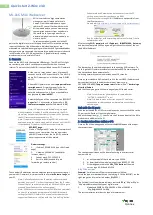
Monitoring the Directory Server from the Command Line
383
Table Header
Description
value differs from
Pages Written Out
in
that these are discarded read-write pages that
have not been modified. Pages discarded from
the cache have to be written to disk, possibly
affecting server performance. The lower the
number of page evicts, the better.
Table 13.5. Global Database Cache Information
13.3.2. Monitoring the Directory Server from the Command Line
The Directory Server's current activities can be monitored using LDAP tools such as
ldapsearch
3
,
with the following characteristics:
• Search with the attribute filter
objectClass=*
.
• Use the search base
cn=monitor
; the monitoring attributes for the server are found in the
cn=monitor
entry.
• Use the search scope
base
.
For example:
ldapsearch -h directory.example.com -p 389 -D "cn=Directory Manager" -w password -s base
-b "cn=monitor" "(objectclass=*)"
The monitoring attributes for the Directory Server are found in the
cn=monitor
entry. For information
on searching the Directory Server, see
Section B.2, “Using ldapsearch”
.
Monitoring the server's activities using
ldapsearch
shows the following information:
Attribute
Description
version
Identifies the directory's current version number.
threads
The current number of active threads used
for handling requests. Additional threads may
be created by internal server tasks, such as
replication or chaining.
connection:fd:opentime:opsinitiated:opscompleted:binddn:
[rw]
Provides the following summary information for
each open connection (only available if you bind
to the directory as Directory Manager):
fd
— The file descriptor used for this connection.
opentime
— The time this connection was
opened.
opsinitiated
— The number of operations initiated
by this connection.
opscompleted
— The number of operations
completed.
The LDAP tools referenced in this guide are Mozilla LDAP, installed with Directory Server in the
/usr/lib/mozldap
directory
on Red Hat Enterprise Linux 5 (32-bit); directories for other platforms are listed in
Section 1.2, “LDAP Tool Locations”
. However,
Red Hat Enterprise Linux systems also include LDAP tools from OpenLDAP. It is possible to use the OpenLDAP commands as
shown in the examples, but you must use the
-x
argument to disable SASL and allow simple authentication.
Содержание DIRECTORY SERVER 8.0
Страница 18: ...xviii ...
Страница 29: ...Configuring the Directory Manager 11 6 Enter the new password and confirm it 7 Click Save ...
Страница 30: ...12 ...
Страница 112: ...94 ...
Страница 128: ...110 ...
Страница 190: ...Chapter 6 Managing Access Control 172 4 Click New to open the Access Control Editor ...
Страница 224: ...206 ...
Страница 324: ...306 ...
Страница 334: ...316 ...
Страница 358: ...340 ...
Страница 410: ...392 ...
Страница 420: ...402 ...
Страница 444: ...426 ...
Страница 454: ...436 ...
Страница 464: ...446 ...
Страница 484: ...466 ...
Страница 512: ...494 ...
Страница 522: ...504 ...
















































